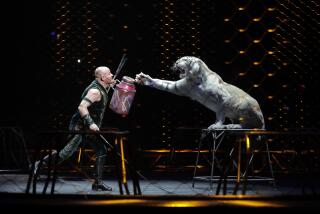Circus maximus
- Share via
The WHOLE searchlight drama around just about every lavish red-carpet event owes more than a nod and an air-kiss to the excitement of the giant American circuses that crisscrossed the United States long ago. “In scope and ambition, the circus invented the rules of engagement for today’s global entertainment industry,” writes editor Noel Daniel in the introduction of “The Circus 1870-1950,” her sumptuous behind-the-tent survey of one of America’s least deeply examined chapters of cultural history. “The circus was the Super Bowl, the Olympics, and the Hollywood blockbuster all in one, brought right to your backyard.”
At more than 600 pages and 900 images, including little-known work by Stanley Kubrick and Charles and Ray Eames, as well as vintage posters and advertisements, “The Circus” isn’t just a sensationalist splash on the circus’ sideshow/carny elements or an inventory of big, elegant beasts. Daniel digs into the sociology of the circus family -- the mobile city of tents, the unprecedented freedom female performers experienced on the road.
Most affecting are the pairings of old circus ads with photos of the actual performers out of “character.”
The peek behind the greasepaint, of performers gathered around the dinner table or in simple street clothes getting into a car, imbues the life with something that is missing from what we think about the entertainment hype machine today, a sort of callused camaraderie that can only come with moving from town to town after a grueling one-night stand; a community of hundreds who must work as one.
-- Lynell George
More to Read
The biggest entertainment stories
Get our big stories about Hollywood, film, television, music, arts, culture and more right in your inbox as soon as they publish.
You may occasionally receive promotional content from the Los Angeles Times.










